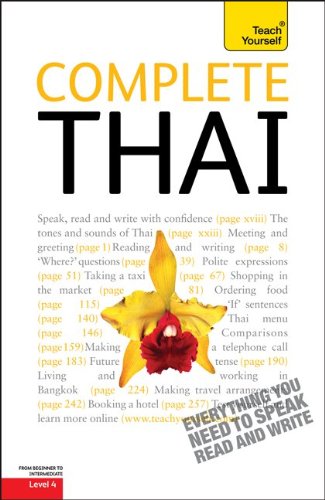When you hire a tutor, learning a language can become quite a pricey endeavor rather fast. Each session with a private tutor is usually priced at more than the cost of the textbook. Group classes may be a bit cheaper, but you have little flexibility when it comes to scheduling and a lot less one-on-one time with the teacher. Instead, why not try to teach yourself? If your aspiration is to learn to speak Thai, then you can do so in no time with the book, “Teach Yourself Thai”.
The “Teach Yourself” series has helped many students learn to speak new languages. Despite the language, the book always follows a similar format. In the case of the “Teach Yourself Thai” book, the reader is first presented with information about pronunciation and transliteration of the language. The book uses both Thai script and transliteration throughout, though presents more Thai script nearer to the end. It’s important that you learn to read and understand the correct pronunciation of both in order to correctly learn Thai using this book.

The book is divided into topical chapters of common scenarios that a beginner student of Thai language would likely face when in Thailand. The first such chapter is about introductions. Here, you learn how to introduce yourself, greet someone at different times of the day, and ask basic questions about the person. The second chapter is about shopping and is titled, “How much is this?” In this chapter, the student will learn how to ask prices, bargain, count, and ask a few questions about products. The chapters go on with similar such topics including sightseeing, asking for directions, placing an order in a restaurant, and so on.
Each chapter starts with a dialogue related to the topic. For example, in the chapter titled, “Do you like living in Bangkok” Chanida and Sue discuss the pluses and minuses of living in the biggest city in Thailand. In the later chapters in the book, there is no English translation given; the dialogue is simply presented in Thai and Romanized Thai. The dialogues can be heard on the CD which can be purchased separately. After the dialogue, there is a small vocabulary box which presents the translations of each of the new words. This vocabulary box is very important, particularly when there is no English translation of the dialogue. The main dialogue is followed by a second dialogue, less related to the overarching theme of the chapter. In this case, the second dialogue is two characters talking about whether or not they like their jobs.
"This approach is different from other books which may just glaze over a number of topics without ever going deep into any one in particular. This approach to fully dissect each topic is helpful for the student to grasp a complete understanding of each topical conversation."
fter the dialogues, students are expected to do a few exercises, practice key expressions and study language notes. Language notes are grammatical tips that will help the student learn the ins and outs of speaking Thai. Each chapter has multiple language notes based on examples found in the dialogues. After the language notes, the students have a few more exercises, some reading and writing practice, and another short dialogue with a few questions. The chapters thoroughly cover each topic, dedicating 10-13 pages for each. This approach is different from other books which may just glaze over a number of topics without ever going deep into any one in particular. This approach to fully dissect each topic is helpful for the student to grasp a complete understanding of each topical conversation.
All in all, “Teach Yourself Thai” lives up to the “Teach Yourself” series standards. The book and audio will help any aspiring student to learn to read, write, and understand a fair bit of Thai in no time at all.




